Argumentative Essay: Social Media's Effect on Relationships
VerifiedAdded on 2022/12/26
|8
|1559
|55
Essay
AI Summary
This argumentative essay delves into the multifaceted influence of social media on the formation and maintenance of human relationships. The essay begins by acknowledging the ease with which social media facilitates connections but also highlights the complexities it introduces, particularly concerning privacy and its impact on interpersonal dynamics. It presents both sides of the argument, citing research that links social media use to increased feelings of loneliness and decreased social skills, while also acknowledging its role in bridging geographical distances and fostering connections. The essay explores how social media can be a platform for equal voices and business opportunities, but also acknowledges the potential for manipulation, misinformation, and the negative impacts of excessive usage on mental health and the development of social skills. It concludes by summarizing the advantages and disadvantages of social media on relationships.
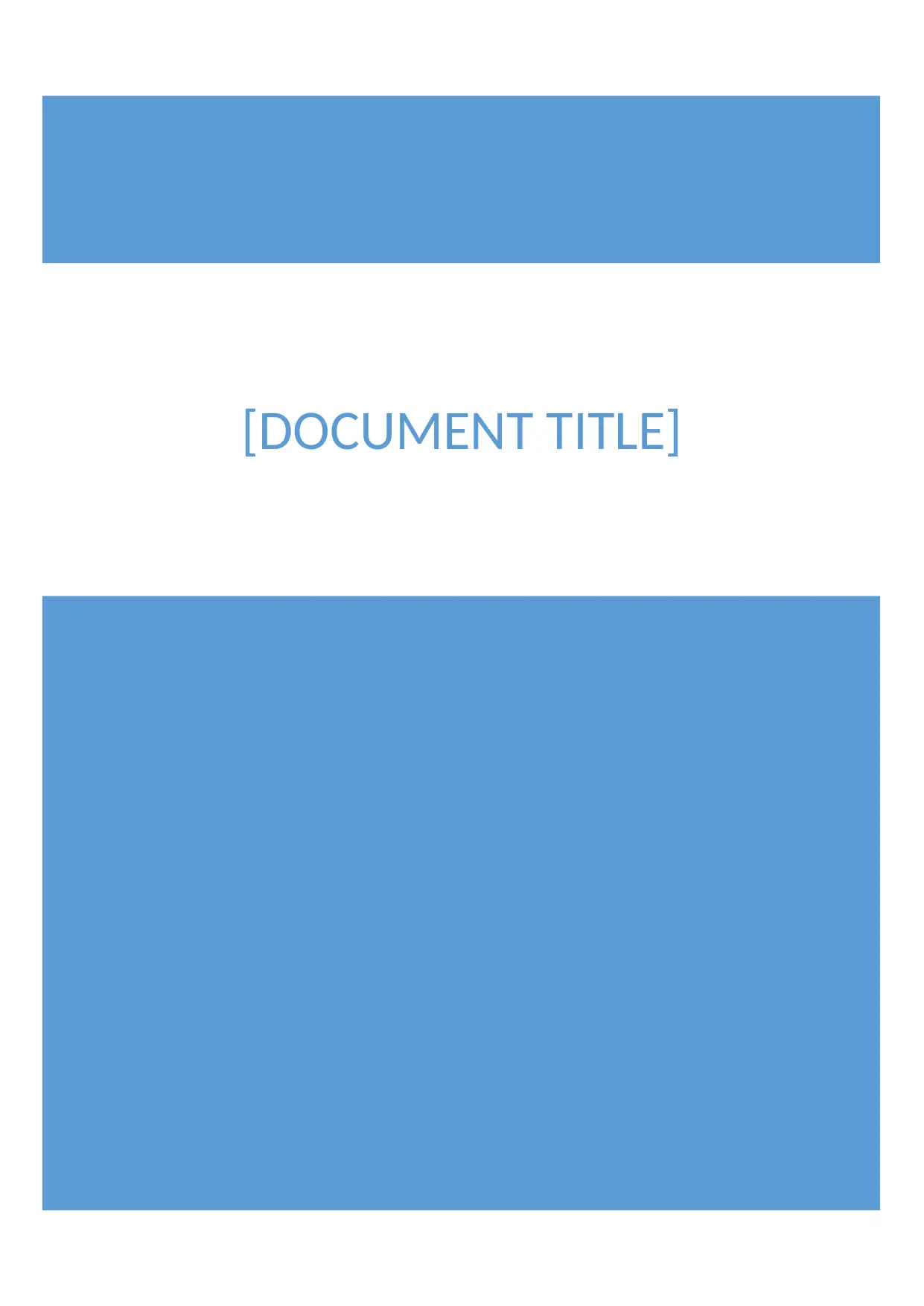
[DOCUMENT TITLE]
Paraphrase This Document
Need a fresh take? Get an instant paraphrase of this document with our AI Paraphraser
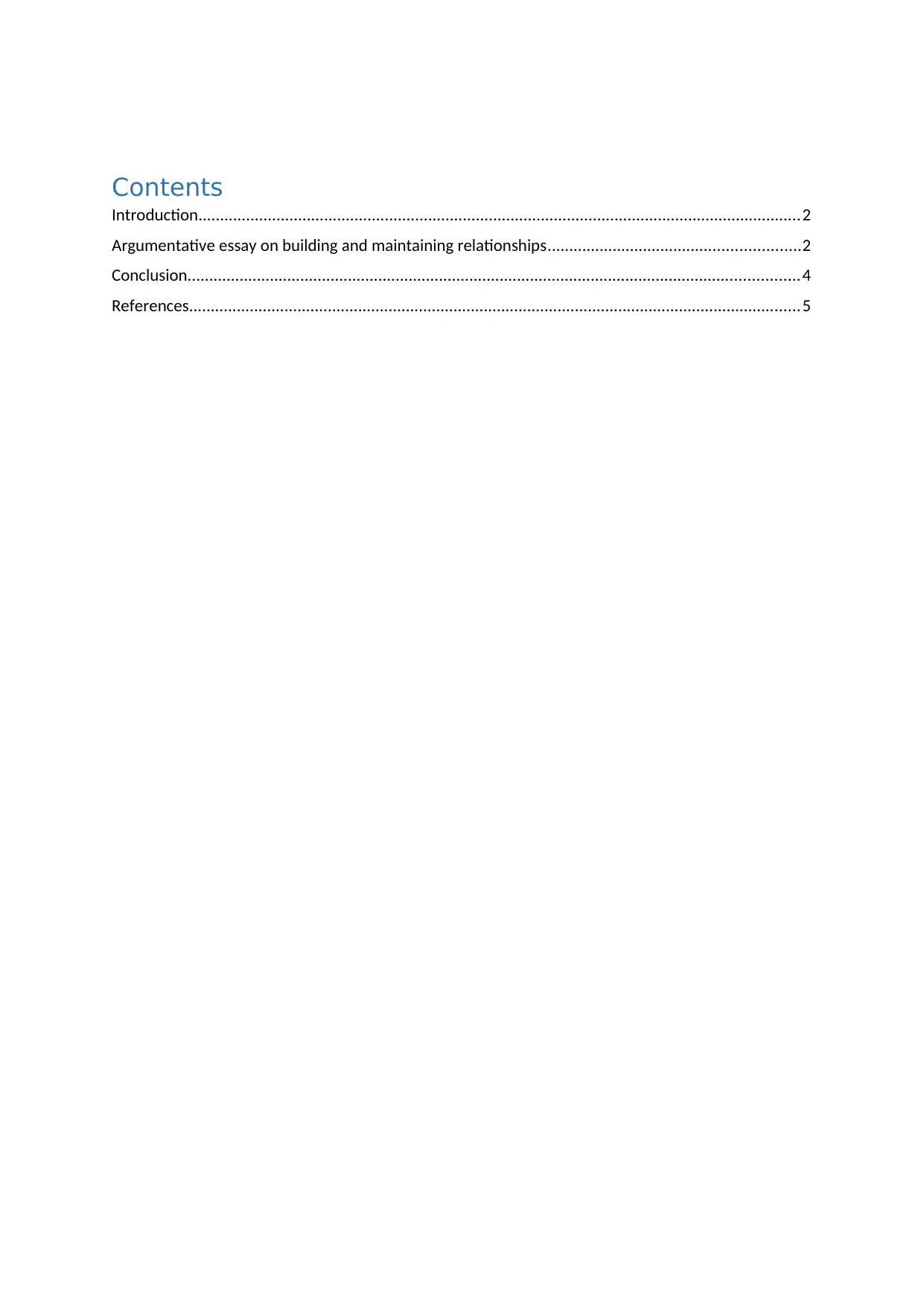
Contents
Introduction...........................................................................................................................................2
Argumentative essay on building and maintaining relationships..........................................................2
Conclusion.............................................................................................................................................4
References.............................................................................................................................................5
Introduction...........................................................................................................................................2
Argumentative essay on building and maintaining relationships..........................................................2
Conclusion.............................................................................................................................................4
References.............................................................................................................................................5
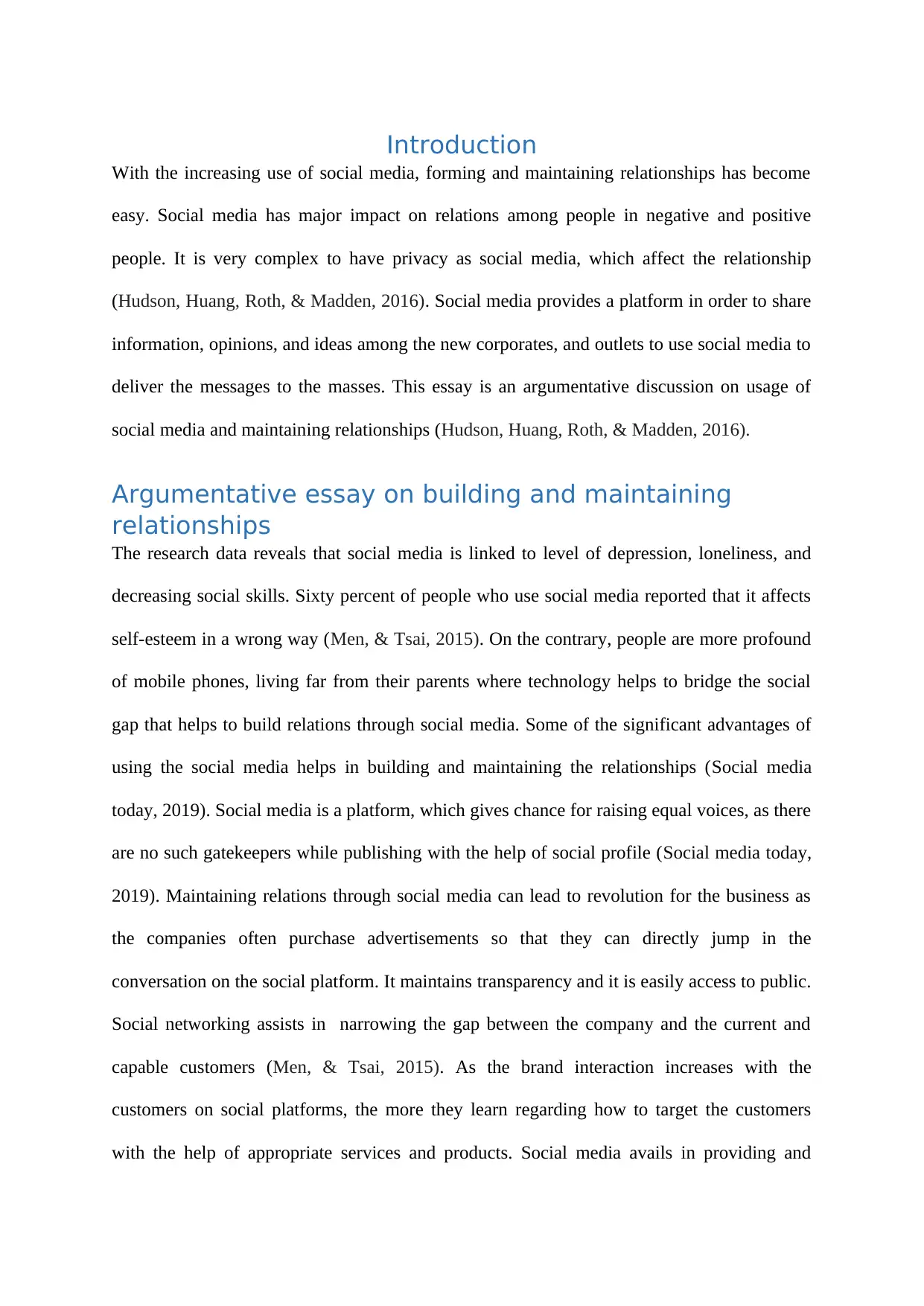
Introduction
With the increasing use of social media, forming and maintaining relationships has become
easy. Social media has major impact on relations among people in negative and positive
people. It is very complex to have privacy as social media, which affect the relationship
(Hudson, Huang, Roth, & Madden, 2016). Social media provides a platform in order to share
information, opinions, and ideas among the new corporates, and outlets to use social media to
deliver the messages to the masses. This essay is an argumentative discussion on usage of
social media and maintaining relationships (Hudson, Huang, Roth, & Madden, 2016).
Argumentative essay on building and maintaining
relationships
The research data reveals that social media is linked to level of depression, loneliness, and
decreasing social skills. Sixty percent of people who use social media reported that it affects
self-esteem in a wrong way (Men, & Tsai, 2015). On the contrary, people are more profound
of mobile phones, living far from their parents where technology helps to bridge the social
gap that helps to build relations through social media. Some of the significant advantages of
using the social media helps in building and maintaining the relationships (Social media
today, 2019). Social media is a platform, which gives chance for raising equal voices, as there
are no such gatekeepers while publishing with the help of social profile (Social media today,
2019). Maintaining relations through social media can lead to revolution for the business as
the companies often purchase advertisements so that they can directly jump in the
conversation on the social platform. It maintains transparency and it is easily access to public.
Social networking assists in narrowing the gap between the company and the current and
capable customers (Men, & Tsai, 2015). As the brand interaction increases with the
customers on social platforms, the more they learn regarding how to target the customers
with the help of appropriate services and products. Social media avails in providing and
With the increasing use of social media, forming and maintaining relationships has become
easy. Social media has major impact on relations among people in negative and positive
people. It is very complex to have privacy as social media, which affect the relationship
(Hudson, Huang, Roth, & Madden, 2016). Social media provides a platform in order to share
information, opinions, and ideas among the new corporates, and outlets to use social media to
deliver the messages to the masses. This essay is an argumentative discussion on usage of
social media and maintaining relationships (Hudson, Huang, Roth, & Madden, 2016).
Argumentative essay on building and maintaining
relationships
The research data reveals that social media is linked to level of depression, loneliness, and
decreasing social skills. Sixty percent of people who use social media reported that it affects
self-esteem in a wrong way (Men, & Tsai, 2015). On the contrary, people are more profound
of mobile phones, living far from their parents where technology helps to bridge the social
gap that helps to build relations through social media. Some of the significant advantages of
using the social media helps in building and maintaining the relationships (Social media
today, 2019). Social media is a platform, which gives chance for raising equal voices, as there
are no such gatekeepers while publishing with the help of social profile (Social media today,
2019). Maintaining relations through social media can lead to revolution for the business as
the companies often purchase advertisements so that they can directly jump in the
conversation on the social platform. It maintains transparency and it is easily access to public.
Social networking assists in narrowing the gap between the company and the current and
capable customers (Men, & Tsai, 2015). As the brand interaction increases with the
customers on social platforms, the more they learn regarding how to target the customers
with the help of appropriate services and products. Social media avails in providing and
⊘ This is a preview!⊘
Do you want full access?
Subscribe today to unlock all pages.

Trusted by 1+ million students worldwide
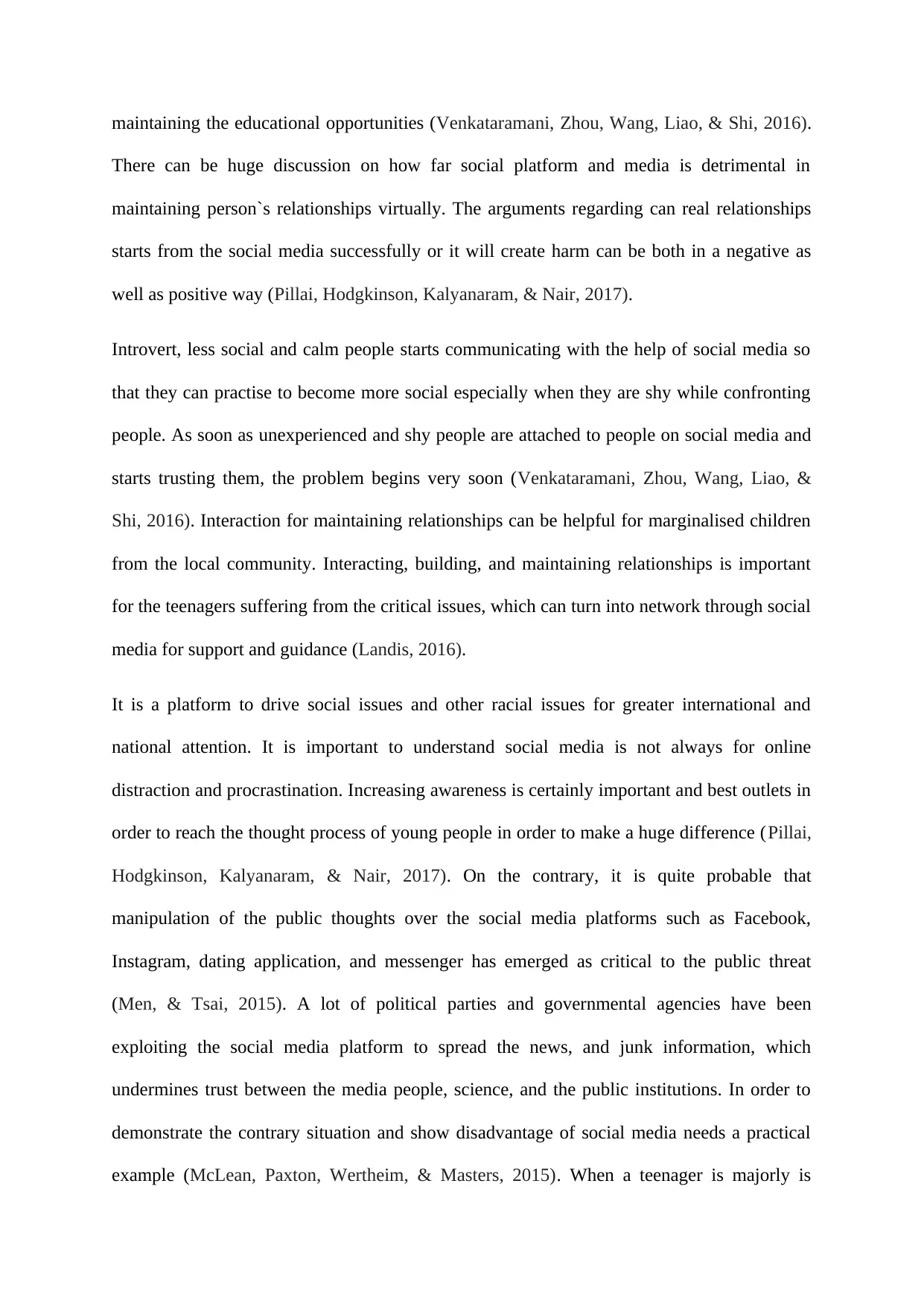
maintaining the educational opportunities (Venkataramani, Zhou, Wang, Liao, & Shi, 2016).
There can be huge discussion on how far social platform and media is detrimental in
maintaining person`s relationships virtually. The arguments regarding can real relationships
starts from the social media successfully or it will create harm can be both in a negative as
well as positive way (Pillai, Hodgkinson, Kalyanaram, & Nair, 2017).
Introvert, less social and calm people starts communicating with the help of social media so
that they can practise to become more social especially when they are shy while confronting
people. As soon as unexperienced and shy people are attached to people on social media and
starts trusting them, the problem begins very soon (Venkataramani, Zhou, Wang, Liao, &
Shi, 2016). Interaction for maintaining relationships can be helpful for marginalised children
from the local community. Interacting, building, and maintaining relationships is important
for the teenagers suffering from the critical issues, which can turn into network through social
media for support and guidance (Landis, 2016).
It is a platform to drive social issues and other racial issues for greater international and
national attention. It is important to understand social media is not always for online
distraction and procrastination. Increasing awareness is certainly important and best outlets in
order to reach the thought process of young people in order to make a huge difference (Pillai,
Hodgkinson, Kalyanaram, & Nair, 2017). On the contrary, it is quite probable that
manipulation of the public thoughts over the social media platforms such as Facebook,
Instagram, dating application, and messenger has emerged as critical to the public threat
(Men, & Tsai, 2015). A lot of political parties and governmental agencies have been
exploiting the social media platform to spread the news, and junk information, which
undermines trust between the media people, science, and the public institutions. In order to
demonstrate the contrary situation and show disadvantage of social media needs a practical
example (McLean, Paxton, Wertheim, & Masters, 2015). When a teenager is majorly is
There can be huge discussion on how far social platform and media is detrimental in
maintaining person`s relationships virtually. The arguments regarding can real relationships
starts from the social media successfully or it will create harm can be both in a negative as
well as positive way (Pillai, Hodgkinson, Kalyanaram, & Nair, 2017).
Introvert, less social and calm people starts communicating with the help of social media so
that they can practise to become more social especially when they are shy while confronting
people. As soon as unexperienced and shy people are attached to people on social media and
starts trusting them, the problem begins very soon (Venkataramani, Zhou, Wang, Liao, &
Shi, 2016). Interaction for maintaining relationships can be helpful for marginalised children
from the local community. Interacting, building, and maintaining relationships is important
for the teenagers suffering from the critical issues, which can turn into network through social
media for support and guidance (Landis, 2016).
It is a platform to drive social issues and other racial issues for greater international and
national attention. It is important to understand social media is not always for online
distraction and procrastination. Increasing awareness is certainly important and best outlets in
order to reach the thought process of young people in order to make a huge difference (Pillai,
Hodgkinson, Kalyanaram, & Nair, 2017). On the contrary, it is quite probable that
manipulation of the public thoughts over the social media platforms such as Facebook,
Instagram, dating application, and messenger has emerged as critical to the public threat
(Men, & Tsai, 2015). A lot of political parties and governmental agencies have been
exploiting the social media platform to spread the news, and junk information, which
undermines trust between the media people, science, and the public institutions. In order to
demonstrate the contrary situation and show disadvantage of social media needs a practical
example (McLean, Paxton, Wertheim, & Masters, 2015). When a teenager is majorly is
Paraphrase This Document
Need a fresh take? Get an instant paraphrase of this document with our AI Paraphraser
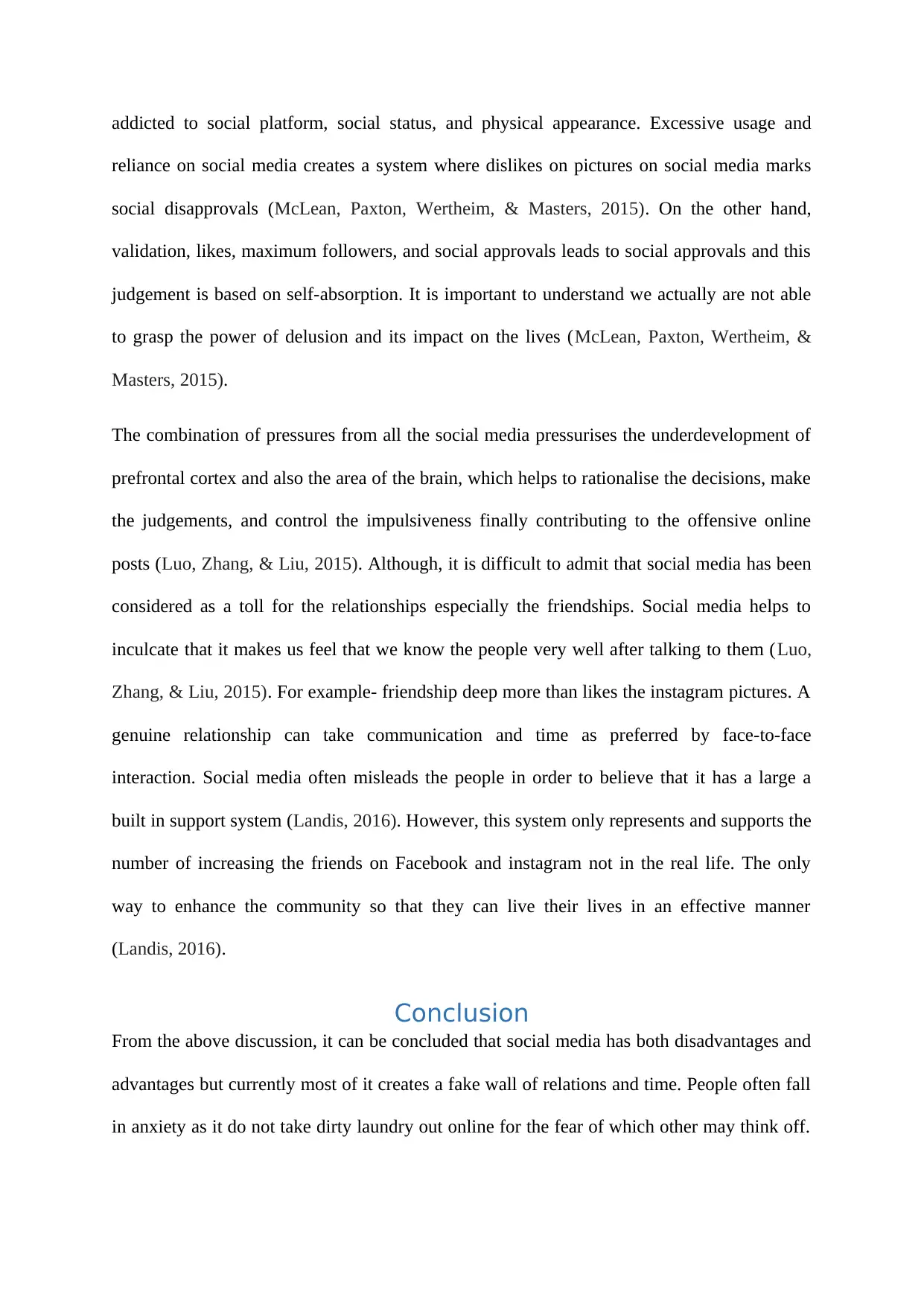
addicted to social platform, social status, and physical appearance. Excessive usage and
reliance on social media creates a system where dislikes on pictures on social media marks
social disapprovals (McLean, Paxton, Wertheim, & Masters, 2015). On the other hand,
validation, likes, maximum followers, and social approvals leads to social approvals and this
judgement is based on self-absorption. It is important to understand we actually are not able
to grasp the power of delusion and its impact on the lives (McLean, Paxton, Wertheim, &
Masters, 2015).
The combination of pressures from all the social media pressurises the underdevelopment of
prefrontal cortex and also the area of the brain, which helps to rationalise the decisions, make
the judgements, and control the impulsiveness finally contributing to the offensive online
posts (Luo, Zhang, & Liu, 2015). Although, it is difficult to admit that social media has been
considered as a toll for the relationships especially the friendships. Social media helps to
inculcate that it makes us feel that we know the people very well after talking to them (Luo,
Zhang, & Liu, 2015). For example- friendship deep more than likes the instagram pictures. A
genuine relationship can take communication and time as preferred by face-to-face
interaction. Social media often misleads the people in order to believe that it has a large a
built in support system (Landis, 2016). However, this system only represents and supports the
number of increasing the friends on Facebook and instagram not in the real life. The only
way to enhance the community so that they can live their lives in an effective manner
(Landis, 2016).
Conclusion
From the above discussion, it can be concluded that social media has both disadvantages and
advantages but currently most of it creates a fake wall of relations and time. People often fall
in anxiety as it do not take dirty laundry out online for the fear of which other may think off.
reliance on social media creates a system where dislikes on pictures on social media marks
social disapprovals (McLean, Paxton, Wertheim, & Masters, 2015). On the other hand,
validation, likes, maximum followers, and social approvals leads to social approvals and this
judgement is based on self-absorption. It is important to understand we actually are not able
to grasp the power of delusion and its impact on the lives (McLean, Paxton, Wertheim, &
Masters, 2015).
The combination of pressures from all the social media pressurises the underdevelopment of
prefrontal cortex and also the area of the brain, which helps to rationalise the decisions, make
the judgements, and control the impulsiveness finally contributing to the offensive online
posts (Luo, Zhang, & Liu, 2015). Although, it is difficult to admit that social media has been
considered as a toll for the relationships especially the friendships. Social media helps to
inculcate that it makes us feel that we know the people very well after talking to them (Luo,
Zhang, & Liu, 2015). For example- friendship deep more than likes the instagram pictures. A
genuine relationship can take communication and time as preferred by face-to-face
interaction. Social media often misleads the people in order to believe that it has a large a
built in support system (Landis, 2016). However, this system only represents and supports the
number of increasing the friends on Facebook and instagram not in the real life. The only
way to enhance the community so that they can live their lives in an effective manner
(Landis, 2016).
Conclusion
From the above discussion, it can be concluded that social media has both disadvantages and
advantages but currently most of it creates a fake wall of relations and time. People often fall
in anxiety as it do not take dirty laundry out online for the fear of which other may think off.

People have started spending few best moments and tweeting regarding the best moments and
tweet with the extraordinary minutes for the day.
tweet with the extraordinary minutes for the day.
⊘ This is a preview!⊘
Do you want full access?
Subscribe today to unlock all pages.

Trusted by 1+ million students worldwide
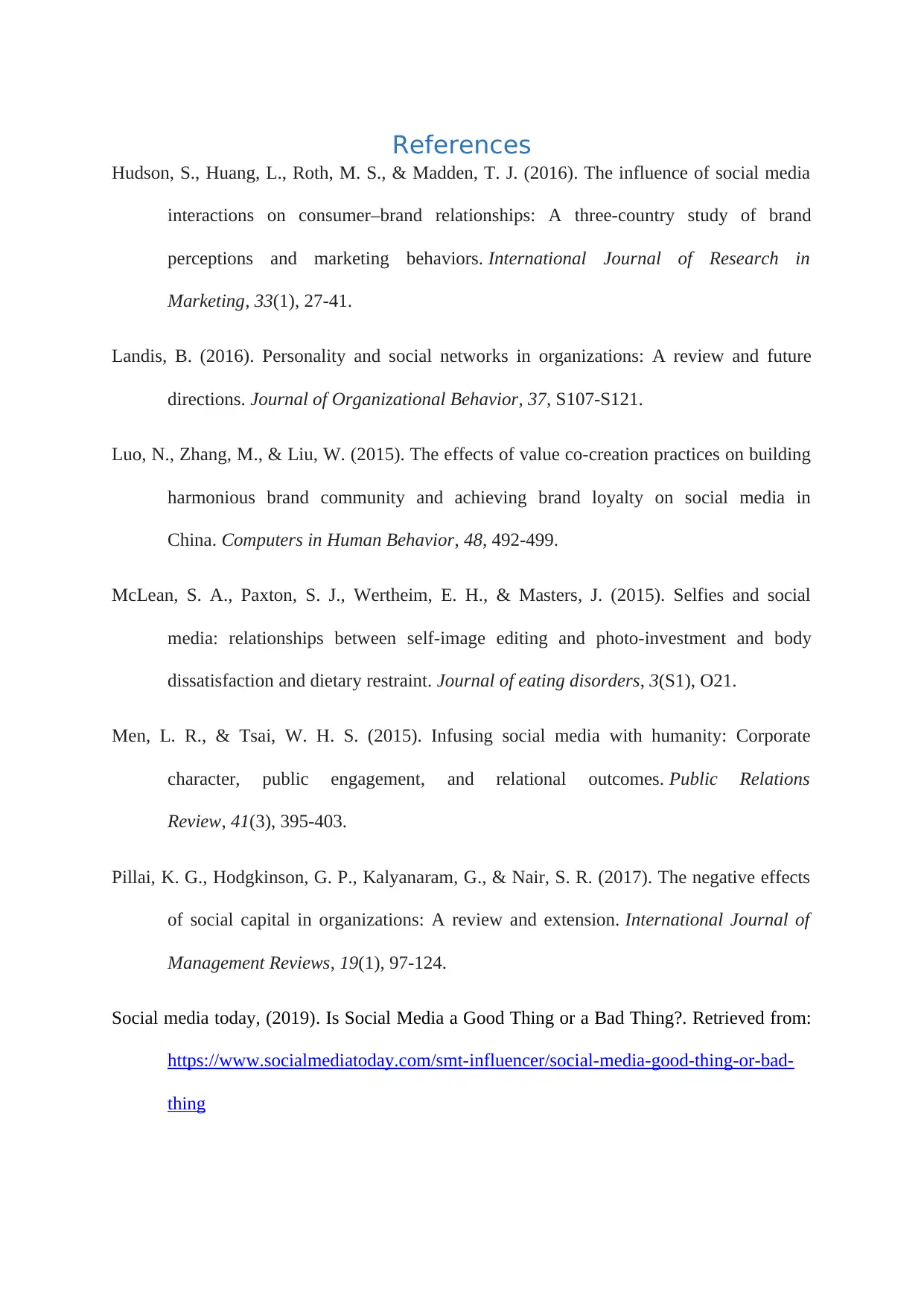
References
Hudson, S., Huang, L., Roth, M. S., & Madden, T. J. (2016). The influence of social media
interactions on consumer–brand relationships: A three-country study of brand
perceptions and marketing behaviors. International Journal of Research in
Marketing, 33(1), 27-41.
Landis, B. (2016). Personality and social networks in organizations: A review and future
directions. Journal of Organizational Behavior, 37, S107-S121.
Luo, N., Zhang, M., & Liu, W. (2015). The effects of value co-creation practices on building
harmonious brand community and achieving brand loyalty on social media in
China. Computers in Human Behavior, 48, 492-499.
McLean, S. A., Paxton, S. J., Wertheim, E. H., & Masters, J. (2015). Selfies and social
media: relationships between self-image editing and photo-investment and body
dissatisfaction and dietary restraint. Journal of eating disorders, 3(S1), O21.
Men, L. R., & Tsai, W. H. S. (2015). Infusing social media with humanity: Corporate
character, public engagement, and relational outcomes. Public Relations
Review, 41(3), 395-403.
Pillai, K. G., Hodgkinson, G. P., Kalyanaram, G., & Nair, S. R. (2017). The negative effects
of social capital in organizations: A review and extension. International Journal of
Management Reviews, 19(1), 97-124.
Social media today, (2019). Is Social Media a Good Thing or a Bad Thing?. Retrieved from:
https://www.socialmediatoday.com/smt-influencer/social-media-good-thing-or-bad-
thing
Hudson, S., Huang, L., Roth, M. S., & Madden, T. J. (2016). The influence of social media
interactions on consumer–brand relationships: A three-country study of brand
perceptions and marketing behaviors. International Journal of Research in
Marketing, 33(1), 27-41.
Landis, B. (2016). Personality and social networks in organizations: A review and future
directions. Journal of Organizational Behavior, 37, S107-S121.
Luo, N., Zhang, M., & Liu, W. (2015). The effects of value co-creation practices on building
harmonious brand community and achieving brand loyalty on social media in
China. Computers in Human Behavior, 48, 492-499.
McLean, S. A., Paxton, S. J., Wertheim, E. H., & Masters, J. (2015). Selfies and social
media: relationships between self-image editing and photo-investment and body
dissatisfaction and dietary restraint. Journal of eating disorders, 3(S1), O21.
Men, L. R., & Tsai, W. H. S. (2015). Infusing social media with humanity: Corporate
character, public engagement, and relational outcomes. Public Relations
Review, 41(3), 395-403.
Pillai, K. G., Hodgkinson, G. P., Kalyanaram, G., & Nair, S. R. (2017). The negative effects
of social capital in organizations: A review and extension. International Journal of
Management Reviews, 19(1), 97-124.
Social media today, (2019). Is Social Media a Good Thing or a Bad Thing?. Retrieved from:
https://www.socialmediatoday.com/smt-influencer/social-media-good-thing-or-bad-
thing
Paraphrase This Document
Need a fresh take? Get an instant paraphrase of this document with our AI Paraphraser
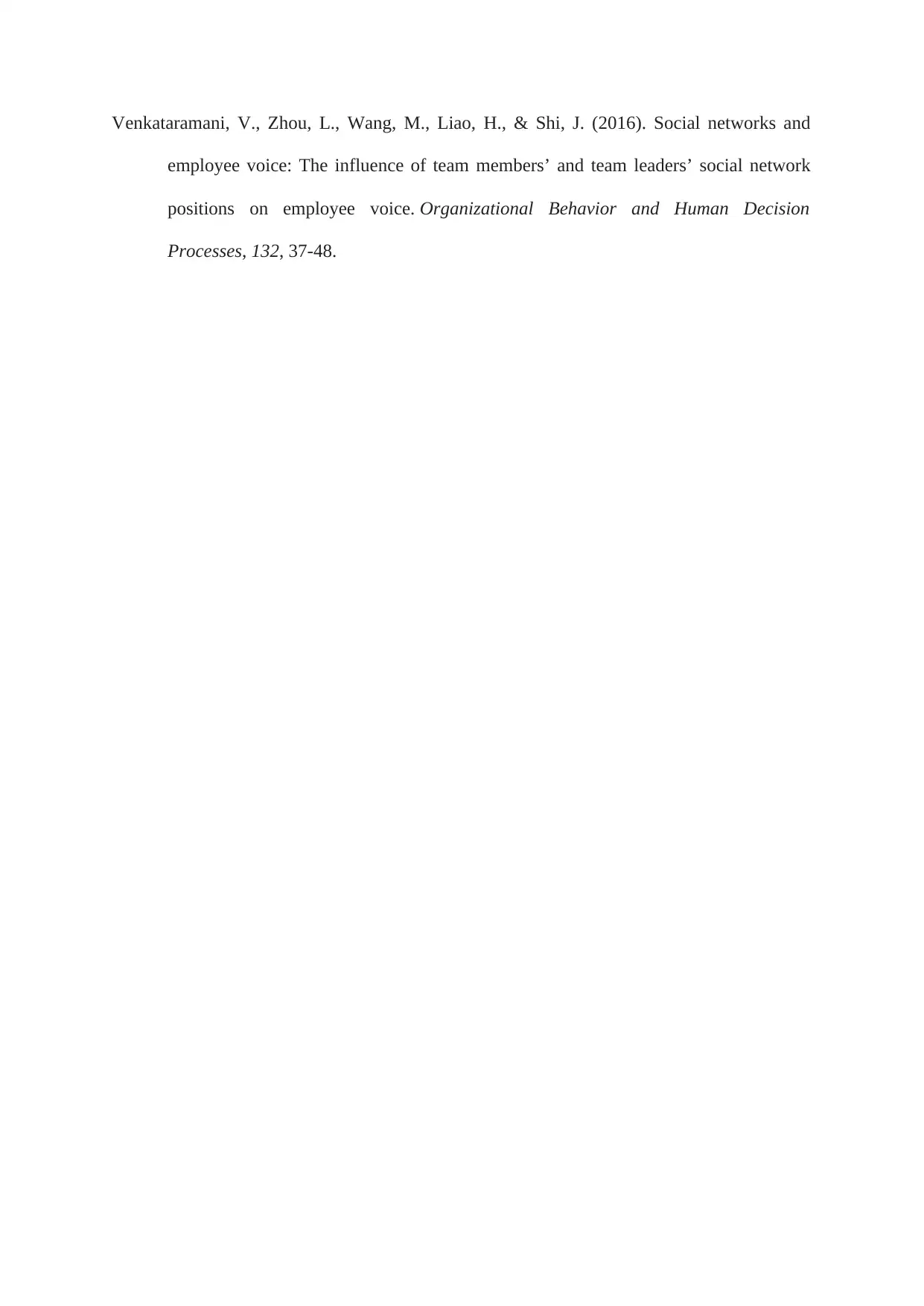
Venkataramani, V., Zhou, L., Wang, M., Liao, H., & Shi, J. (2016). Social networks and
employee voice: The influence of team members’ and team leaders’ social network
positions on employee voice. Organizational Behavior and Human Decision
Processes, 132, 37-48.
employee voice: The influence of team members’ and team leaders’ social network
positions on employee voice. Organizational Behavior and Human Decision
Processes, 132, 37-48.
1 out of 8
Your All-in-One AI-Powered Toolkit for Academic Success.
+13062052269
info@desklib.com
Available 24*7 on WhatsApp / Email
![[object Object]](/_next/static/media/star-bottom.7253800d.svg)
Unlock your academic potential
Copyright © 2020–2025 A2Z Services. All Rights Reserved. Developed and managed by ZUCOL.

